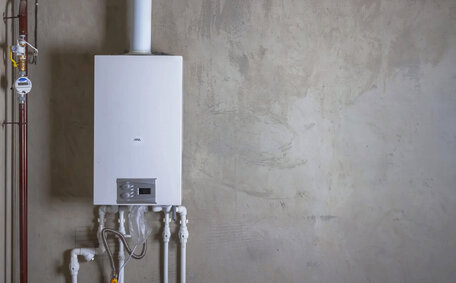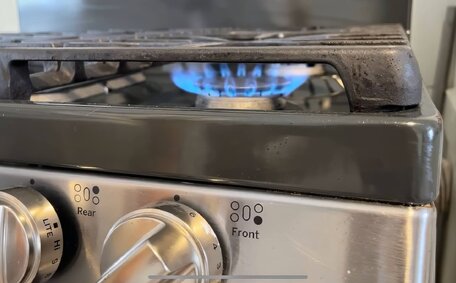Overview of Hot Water System Regulations in Australia
In Australia, hot water systems are regulated to safeguard users by setting temperatures that will prevent bacterial growth and minimize the risk of scalding.
- All new hot water installations must have a temperature control device to ensure delivery temperatures do not exceed 50°C in bathrooms and laundries or 60°C in other areas.
- Non-residential buildings can have water temperatures up to 50°C to satisfy commercial hygiene requirements.
- Thermostatic mixing valves can be used to turn hot water temperatures down at the point of use to prevent scalding while maintaining supply temperatures hot enough to control Legionella bacteria.
- Only a qualified plumber can install, replace or adjust a thermostatic mixing valve and other temperature control devices.
This article will detail the regulations for hot water systems, including property-specific requirements, control devices, and the consequences of non-compliance.
Key Temperature Requirements
Australian hot water systems must adhere to stringent temperature requirements as dictated by the Plumbing Code of Australia and the relevant Australian Standards.
The key regulations are:
- Storage temperatures must be at least 60°C to control Legionella bacteria.
- For personal hygiene purposes such as showers and baths, the maximum water delivery temperature is capped at 50°C to prevent burns.
- Delivery temperatures higher than 50°C, up to 70°C are allowed for commercial sanitary purposes such as commercial kitchens.
- All new installations must have an approved temperature control device to ensure delivery temperatures are not hot too, exceeding the 50°C limit for bathrooms, ensuites and laundries.
Thermostatic mixing valves near the output points of new or existing hot water systems offer additional safety, mixing hot and cold water to reduce temperatures down to 37°C for extra protection of vulnerable individuals, while the system still sustains higher temperatures for disinfection.
Complying with your tap’s hot water system temperature requirements curtails scalding risks while securing sufficient heat to control bacteria. Only licenced plumbers can install, adjust, or replace your hot water heater’s temperature control equipment.
Preventing Scalds with 50°C Limit
The 50°C delivery temperature limit for hot water at personal hygiene outlets is essential to prevent scalding; water temperatures above this threshold can lead to severe burns within seconds.
At:
- 50°C, it can take 5 minutes of exposure for a serious scald
- 55°C, it takes 30 seconds
- 60°C, it takes 5 seconds
- 68°C, it takes just 1 second
Children, the elderly, and individuals with disabilities are particularly at risk of scalding from hot tap water. It’s vital to ensure that your water temperature does not exceed 50°C at bathroom and laundry fixtures.
Australian regulations mandate that all new hot water system installations include a tempering valve or another approved mechanism to automatically cap the temperature at 50°C for high-risk outlets.
Tempering valves can set delivery temperatures and make adjustments to water temperature, and installing thermostatic mixing valves close to outlets provides an extra safeguard against scalds. They can lower temperatures further to accommodate vulnerable users.
Ensuring Safe Temperatures in Special Facilities
Facilities installing or upgrading water systems for children, elderly, and those with disabilities encounter more stringent hot water temperature regulations.
The maximum delivery temperature for these premises is 45°C, hence run cold water to help prevent scalding. At 45°C it takes 5 minutes to cause third-degree burns, pointing to the dangers of hot water compared to just 1 second at 68°C.
Reasons for the lower 45°C limit include:
- Children and elderly people have thinner skin increasing scald risk
- Those with disabilities may not be able to move out of the way of hot water as quickly
- Caretakers bathing occupants must be protected
- Lower temperatures accommodate disability equipment like shower chairs
All plumbing work in these facilities must be completed by qualified professionals to ensure full compliance with hot water safety regulations.
Maintaining 60°C Storage to Prevent Bacterial Growth
Hot water systems in your home with solar heat collectors must maintain a storage temperature of 60°C or higher to control dangerous bacteria like Legionella.
At temperatures below 60°C, hot water storage can harbour bacteria, multiplying and creating health risks if transmitted via aerosols from taps and showers.
Key regulations require:
- Water tanks, particularly for natural gas heaters, must be installed according to the manufacturer’s guidelines to ensure safe operating temperatures are reached.
- Gas or electric hot water systems must provide enough power to maintain water at the safe temperature of over 60°C.
- Storage tanks must be well insulted meet standards for heat retention.
- Annual inspections are required to verify that storage temperatures consistently remain above 60°C, which also lessens the chance of increased greenhouse gas emissions due to inefficient system function.
Installing larger storage tanks or solar hot water systems can assist in reaching the required 60°C temperature. Or, upgrading to a more robust electric hot water system may be required.
Failure to consistently maintain 60°C storage puts occupants health at risk. Only qualified plumbers can install or alter systems to achieve safe temperatures.
Installation and Maintenance Requirements
Compliance with Australian hot water regulations necessitates proper installation and maintenance by qualified professionals.
Key Installation Requirements
All hot water system installations must ensure proper temperature water controls are in place:
- Utilise a licensed plumber for professional installation
- Follow the Plumbing Code of Australia and manufacturer specifications
- Include an approved temperature control device like a tempering valve
- Achieve safe storage (60°C+) and delivery temperatures
- Provide insulation meeting Australian Standards
- Ensure electrical installations conform to the current standards
Using accredited installers ensures regulations are met and gas emissions from the installation process are minimized.
Maintenance for Ongoing Compliance
To remain compliant, all hot water systems should undergo:
- Annual safety checks of storage/delivery temperatures
- Routine replacement of anodes and heating elements
- Leak checks and relief valve testing
- Insulation repairs if damaged
- Filter cleaning if applicable
- Descaling procedures to address water hardness problems
Preventative maintenance keeps hot water systems operating safely and efficiently for longer.
Upgrading hot water plumbing to systems that minimise greenhouse gas emissions and comply with current regulations is recommended. New higher efficiency systems with technology certificates, STCs, save money and reduce emissions while upholding safety regulations.
Using Tempering Valves to Regulate Temperature
Tempering valves play a critical role in regulating hot water temperatures to safe levels that meet Australian regulations.
A tempering valve is usually installed near the hot water heater. It automatically mixes heated water from the tank with cold water to ensure delivery temperatures do not exceed:
- 50°C for personal hygiene uses like showers and bath taps
- 45°C for facilities accommodating vulnerable people
- 70°C for some commercial sanitary purposes
Without a tempering valve, hot water can easily reach 60-75°C resulting in nearly instant severe scalding. Tempering valves provide passive safety by capping temperatures.
For added protection at specific outlets, thermostatic mixing valves can balance the temperature of hot water to prevent tap burns while controlling bacteria.
Only qualified plumbers can install, adjust or replace tempering valves or thermostatic mixing valves. Valves require annual checks to ensure they are operating properly and limiting temperatures to safe levels.
Upgrading to the most common tempering valves or modernising hot water delivery systems is crucial for preventing scalds and upholding hot water regulations in Australia.
Replacing Systems May Require New Temperature Controls
When replacing water heaters in Australia, it’s pivotal to assess whether the existing temperature control equipment adheres to current regulations or necessitates upgrading.
Key considerations for replacing hot water systems when your hot water is inefficient or outdated include:
- New solar heat pump systems or continuous flow gas systems require electronic control pads to incessantly monitor outlet temperatures. Older mechanical tempering valves may no longer suffice.
- Heat pump hot water systems use different technologies requiring tailored temperature regulation suited to the heat source.
- If the unit was manufactured before requisite tempering valves became mandatory, a new valve must be installed with the new system.
- Premises with vulnerable occupants may need thermostatic mixing valves at outlets that can lower temperatures below tempering valve settings.
Upon replacement, a licenced plumber will ensure they install your new hot water system with up-to-date temperature controls to prevent scalding while securely maintaining adequate heat to control bacteria.
Upgrading obsolete temperature regulation devices when replacing hot water systems is essential for safety and regulatory compliance.
Tips for Homeowners and Installers
To maintain hot water system compliance and safety in Australian homes and businesses, follow these tips:
- Have all installations and alterations completed by qualified plumbers following manufacturer instructions and regulations
- Inspect temperature control devices like tempering valves annually and replace if faulty
- Check storage systems and tank insulation and repair damage to retain heat
- Replace sacrificial anodes regularly to prevent tank corrosion
- Service relief valves, heating elements and electronics as per advice to ensure functionality
- Consider continuous electronic monitoring via control pads if high-risk occupants are present
- Keep detailed service records for potential property buyers assessing system condition
- Monitor delivery temperatures from bathroom taps regularly to identify faults
Choose energy-efficient models with modern tempering valve technology to reduce operating costs and enhance safety when selecting new systems.
Staying informed on hot water regulations through qualified plumbers ensures households and businesses remain compliant.
Choosing and Maintaining Compliant Hot Water Systems
Choosing a new hot water system in Australia requires selecting a model that meets all regulations to ensure scald prevention and effective bacterial control.
Key factors to consider include:
- Determine the system type needed – whether storage, instantaneous, or heat pump
- Efficiency rating – A higher efficiency rating is better to save a significant per cent on electricity bills
- Warranties for peace of mind
- Smart controls and WiFi connectivity for ease of use and monitoring
- Suitable capacity for your household’s usage
- Inclusion of a tempering valve to maintain the 50°C delivery temperature limit
It is also vital to maintain your system with annual plumbing checks to ensure:
- Storage temperatures consistently exceed 60°C
- Tempering valves are functioning properly
- No faults impeding temperature regulations
- Heating elements, anodes and other consumables are replaced as required
Following manufacturer servicing advice and upgrading ageing systems ensures ongoing hot water safety for your family while remaining compliant.
Hiring Qualified Professionals for Installation
Installing or altering hot water systems requires qualified professionals to ensure compliance with Australian regulations. Using licenced plumbers is crucial for correctly:
- Selecting adequately sized and efficient systems for your needs
- Positioning, mounting and connecting tanks safely
- Integrating certified tempering valves to regulate the hot water tank outlet temperatures
- Achieving safe storage temperatures over 60C to prevent Legionella
- Insulating tanks and pipes to standards
- Advising on control options for your situation like thermostatic mixing valves
Attempting DIY installation risks non-compliant configurations prone to faults jeopardising safety. Without professional help, you may unknowingly:
- Install inadequate temperature regulation
- Use inferior insulation resulting in heat loss
- Mount tanks unsafely risking leaks or failures
Utilising qualified tradespeople also provides consumer protections if defects occur. They can make sure to guide you through the standards for your premises to choose suitable systems.
For total peace of mind, you do need a new hot water system that meets regulations protecting your household and hire qualified plumbers for all installations and maintenance.





